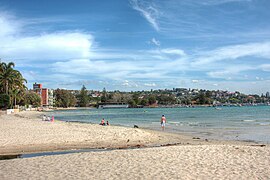Rose Bay, New South Wales
|
Rose Bay Sydney, New South Wales |
|||||||||||||
|---|---|---|---|---|---|---|---|---|---|---|---|---|---|

On the shore of Rose Bay
|
|||||||||||||
| Population | 9,401 (2011 census) | ||||||||||||
| Postcode(s) | 2029 | ||||||||||||
| Location | 7 km (4 mi) east of Sydney CBD | ||||||||||||
| LGA(s) | Waverley Council | ||||||||||||
| State electorate(s) | Vaucluse | ||||||||||||
| Federal Division(s) | Wentworth | ||||||||||||
|
|||||||||||||
Rose Bay is an affluent harbourside, eastern suburb of Sydney, in the state of New South Wales, Australia. Rose Bay is located seven kilometres east of the Sydney central business district, in the local government areas of Waverley Municipal Council (east of Old South Head Road) and Woollahra Council (on its western side towards the bay).
Rose Bay has views of both the Sydney Opera House and the Sydney Harbour Bridge together. Lyne Park abuts Sydney Harbour on its west. Shark Island is located in Sydney Harbour, just north of Rose Bay.
Rose Bay was named after the Right Honourable George Rose, who was joint Secretary to the British Treasury with Thomas Steele, after whom Steel(e) Point at Nielsen Park was named. The name Rose Bay was used as early as 1788 by Captain John Hunter.HMAS Tingira, named after an Aboriginal word for 'open sea' was moored in Rose Bay from 1912 to 1927. It was used to train over 3,000 Australian sailors, many for service in World War I. There is a small park on the Rose Bay waterfront which commemorates Tingira.
From 1938, seaplanes landed in Sydney Harbour on Rose Bay, making this Sydney's first international airport, and what is now Rose Bay Water Airport. On 14 September 1945, nine Catalina flying boats landed and moored at the Rose Bay wharf, repatriating Australian prisoner of war, survivors of Japanese camps. Sydneysiders looked on in silence, aghast at the emaciated state of the returning soldiers. There is a nearby restaurant called Catalina, referencing the aircraft of the same name.
...
Wikipedia
